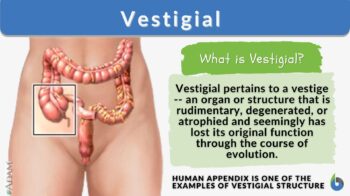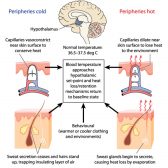
Vestigial
adj.
[vɛˈstɪdʒɪəl]
Definition: of, relating to, or describing a vestige, a rudimentary or degenerate structure
Table of Contents
Vestigial (organ) is a degenerate organ or structure or physical attribute that has little to no function in the species but possessed an essential function in the preceding evolutionary form of the species. It is the retention of genetically-encoded structure accompanied by loss of function in the species.
Evolution is the driving force of nature. Different factors and phenomena like variations, mutations, gene flow, genetic drift, and natural selection have together ensured that evolution is a continuous process through the ages and even at present. Since species as a unit is subject to evolution rather than an individual, there are several features, characters, and functions that become more or less useful in a species group over millions of years. In simple words, new characters and functions evolve in a species over evolutionary time periods. Similarly, ancestral characters and functions are sometimes lost in a species over evolutionary time periods.
Among many different phenomena studied in the subject of Evolutionary Biology, one is vestigiality. In the evolutionary theory, vestigiality is explained as the phenomenon of retention of genetically encoded physical structure which has lost its biological ancestral function in the given species. In this article, we will emphasize the rationales and examples of this phenomenon. This terminology from which the word “vestigial” is derived will be the topic of today’s discussion. Read on to learn how vestigial organs come into existence, their natural history, and much more.
Vestigial Definition
Vestigial is a term generally used to describe degenerate body structures that seem to have lost their original functions in the species over an evolutionary timescale. A vestigial structure or character shows similarity in the speculated functional attributes to the related species. This is the reason that vestigial organs are understood better by comparing them with homologous organs (organs with common ancestry or common descent) in related species.
Vestigial Etymology
Vestigial is a modern English word derived from two words — a Middle French first word ‘vestige’ that was further derived from an older Latin word ‘vestīgium’ meaning “an apparent surviving evidence of something that existed once but doesn’t exist anymore or a footprint or a track” and a Latin second suffix ‘al’ meaning “having the form of/about”.
Watch this vid about vestigial structures n our bodies that are “leftover” from previous human evolutionary phases:
The term vestigial is a descriptive word pertaining to a vestige, which may be an organ, a structure, or a body part that is degenerate or rudimentary. Through the course of evolution, a vestige may have been greatly reduced from the original ancestral form and function. Thus, many vestiges are no longer as functional or their function has altered through time. As such, vestigial structures may provide a clue to the evolutionary history of a species because they are remnants of structures found in ancestral species.
Vestigial Explanations
Vestigial organs are believed to have manifested due to continuous evolutionary processes across species. The most commonly accepted scientific explanation for vestigial structures is the “loss of function” in a well-characterized organ or structure. This could be further explained by the “termination or cessation of positive selection pressures” for the given function of a structure. Such termination of directional selection pressure could be due to minimal or no value addition by the given physical structure of the species.
To make it clearer, when a body structure doesn’t benefit the species, the evolutionary forces “stop” selecting that feature in the species line, and over billions of years, the structure eventually loses its function in the species and hence becomes vestigial.
Another important point to note here is that sometimes when a structure isn’t providing an essential function or benefit but is also not harming the species per se, the evolutionary forces do not “rush” in eliminating the structure itself. That’s why in such a case, only the function stops to manifest while the physical structure persists and remains of no use to the species.
Vestigial and other terminologies
Several other terminologies are also used to explain structures and organs that are vestigial.
- Rudimentary structures or organs
- Atrophied structures or organs
- Degenerate structures or organs
Vestigiality Phenomenon
The phenomenon of vestigiality can appear in different aspects:
- Patterns of behavior
- Morphological and human anatomy structures
- Physiological and biochemical processes
All of these features are genetically encoded but lose their behavioral, morphological, anatomical, physiological, or anatomical functions from the evolutionary past. The manifestation of vestigiality is diverse in the sense that physical vestigial features can appear, persist, develop, or even disappear at different stages within the organism’s life cycle. This can range from as early as the embryonic developmental stage to late adulthood.
What are Examples of Vestigial?
There are several instances of vestigiality in many animals and human beings. Some of the important and commonly studied examples of vestigial features and organs are listed below.
Flightless island birds
Several island birds have vestigial wings (non-functional wings). Some commonly known examples of flightless birds are:
- Kiwi
- Penguin
- Ostrich
- Inaccessible Island Rails (smallest flightless bird in the world)
- Steamer duck
- Kakapo
- Takahe
- Cassowary
- Dodo (now extinct)

NOTE IT!
“Inaccessible Island Rails: The Flightless Birds”
The “loss of flight function” in island birds is a classic example of vestigiality. An important case study on “Inaccessible Island Rails”– the smallest living flightless bird on the planet Earth revealed how the phenomenon of vestigiality plays out.
This bird is found only on Inaccessible Island (a volcanic island in the South Atlantic Ocean). The island belongs to the Tristan Archipelago (the most remote and inhabited archipelago on Earth). It was earlier believed that the bird reached the island via land bridges and land connections. The bird’s most close relatives were found on the South American mainland which is quite far. And surprisingly, all the common ancestors possessed the ability to fly. The study by Stervander et al. (2019) finally resolved the uncertainties and long-existing doubts about how the flightless bird reached the island then. (Ref.1)
Rationale by Stervander et al. (2019): The phylogenetic analysis conducted by Stervander using DNA markers revealed that the bird possessed the ability to fly at some point in evolutionary time. But as the bird reached the island (not sure if it flew itself or was flown by storm), the “need to fly” in search of food resources or escape-coping mechanism from predators wasn’t required, thus rendering it completely useless or vestigial (counterproductive) for the bird. This led to the loss of functional wings in the Inaccessible Island Rails; and displays the incredible phenomenon of vestigiality.

Vermiform appendix in humans
The vermiform appendix in humans is also an example of a vestigial structure since its ancestral digestive function is no more present.

Appendix testis of males
Appendix testis is another vestigial feature in the human body (males).

Vomeronasal organ in humans
Vomeronasal organ (VNO) also called Jacobson’s organ is also an example of the vestigial organ in human beings. While some people might have a remnant VNO, it’s basically non-functional (useless leftovers) in humans.

Hindlimbs in snakes and whales
Hindlimbs in snakes and whales are another example of vestigial features (vestigial limb) in other animals.
Human coccyx
Coccyx (also called the tailbone) is another example of a vestigial organ in human beings. It is the remnant of a lost tail. It is a residual structure present in either ancestral forms or only during embryonic development in even humans. In human embryos, a tail is present (with only 10-12 vertebrae). This is present during the 5-6th week of intrauterine life. And it eventually disappears by the 8th week. It is speculated that a true human tail formation occurs from the most distal portion of the embryonic tail. Also, it does not comprise any bone, cartilage, notochord, or spinal cord.
 
Figure 6: Coccyx is a vestigial tail in humans. It is the triangular arrangement of bone at the very bottom of the spine, just below the sacrum. Image Credit: Wikimedia (skeletal system on the left, coccyx highlighted in red color on the right). |
Vestigial eyes of salamanders and cavefish
The vestigial eyes of salamanders and cavefish are another example of rudimentary features across the animal kingdom. Their eyes don’t allow them to see.

Wisdom teeth in humans
Wisdom teeth are also considered vestigial in nature in human beings. They are the set of 3rd molars in the human teeth set. They were integral for our ancestors to grind plant materials, which was the primary human diet then.

Take the quiz!
References
- Stervander, M., Ryan, P. G., Melo, M., & Hansson, B. (2019). The origin of the world’s smallest flightless bird, the Inaccessible Island Rail Atlantisia rogersi (Aves: Rallidae). Molecular phylogenetics and evolution, 130, 92–98. https://doi.org/10.1016/j.ympev.2018.10.007
- Clarke J. A. (2019). Genomic mechanisms for the evolution of flightlessness in steamer ducks. Nature, 572(7768), 182–184. https://doi.org/10.1038/d41586-019-02234-y
- Roots, C. (2006). Flightless birds. Greenwood Publishing Group.
- Jeffery, W. R. (2009). Regressive evolution in Astyanax cavefish. Annual review of genetics, 43, 25-47.
- Bergman, J. (2000). Do any vestigial structures exist in humans. Creation Ex Nihilo Technical Journal, 14(2), 95-98.
- Belzberg, A. J., Myles, S. T., & Trevenen, C. L. (1991). The human tail and spinal dysraphism. Journal of pediatric surgery, 26(10), 1243-1245.
©BiologyOnline.com. Content provided and moderated by Biology Online Editors.








